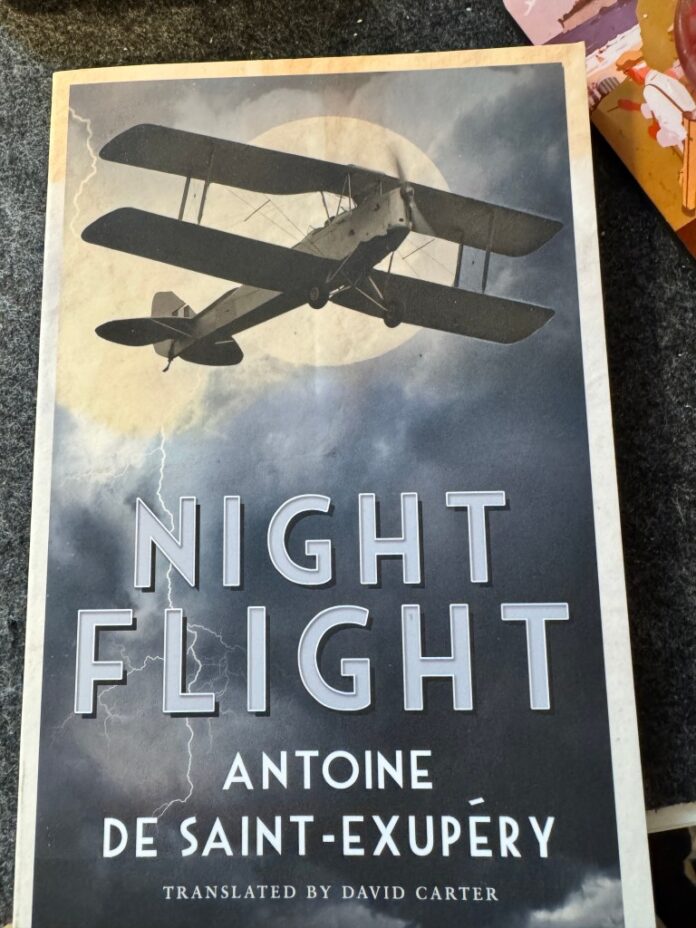Night Flight by Antoine De Saint -Exupéry
French fiction
Original title – Vol de Nuit
Translator – David Carter
Now, there is a writer you read when young and never really went back to reading when older. For me, it would be Saint-Exupery. I think a lot of kids of my generation, the Little Price was a book we all reread and loved. Still, I was always more of a fan when, in my teens of those books he wrote taken from his flying, I found an old penguin edition of Southern Mail. I discovered that he had written several books about his time flying the mail to various places worldwide. This was when the flight was just taking off, unlike now, which went from place to place. This was a time of smaller propeller planes that would struggle in certain weather conditions. We see how he captures those brave fliers and those around them.
AND SO THE THREE MAIL PLANES, trom Patagonia, Chile and Paraguay, returned from the south, the west and the north towards Buenos Aires. Their cargoes were awaited there in order for the Europe plane to leave around midnight.
Three pilots, each of them behind a hood which was as heavy as a barge, and lost in the night, were meditating on their flights and coming down slowly towards the enormous city from their stormy or peaceful sky, like strange peasants coming down from their mountains.
Rivière, who was responsible for the whole network, was walking to and fro on the airfield at Buenos Aires.
He remained silent, for until the three airplanes had arrived it would continue to be a day of dread for him.
With every passing minute, as the telegrams reached him, Rivière was conscious of being able to snatch something from fate, of reducing the sum of what was unknown and of dragging his crews out of the night and ont the shore.
The way he has set up his buisness
The book follows a time when De Saint-Exupéry was a postal flyer in Argentina. In the novel, he follows the setting up of the services through the eyes of the man who runs the services. Rivière has decided it may help improve the service if the flyers do night flights. The book follows one night when Fabian, one of his pilots, is heading to [atagonika to deliver and collect mail, which will later be sent to Paris and then on a flight to Europe. But when Fabian said the weather was changing for the worse, we started questioning Rivière’s actions around the flight as we jumped between the Base in Buenos Aires and Fabian in his plane until he is finally caught in a cyclone and radio contact is cut. This hits home later when Fabian’s wife looks to discover what happened to her husband. Meanwhile, the other two night flights with Mail made it back to the base, and he set the flight with nMail to Paris.
THE SECRETARIES WERE DOZING in the Buenos Aires offices when Rivière went in. He had kept his coat and hat on and looked, as always, like an eternal traveller.
He passed through almost unnoticed, so little space did his small figure take up, and so well did his grey hair and anonymous clothes blend into every setting. And yet the men became animated with enthusiasm. The secretaries showed concern, the office manager went through the recent documents with a sense of urgency and the typewriters clattered.
The telephone operator was pushing his plugs into the switchboard and noting down the telegrams in a thick book.
Rivière sat down and read them.
I was struck how different things would be now with modern tech.
What isn’t to love in this book it captures Man’s struggles against Nature, so we see the young flyer Fabian struggle with a treacherous flight to the very southern part of Argentina Patagonia. We see how quickly the weather could change a night without modern equipment to see the cyclone coming which he ends up crashing because he hadn’t seen it coming.. It also captures the nature of those early years of Commercial flying and how Riviere has to make decisions that affect what happens to Fabian and his other pilots as he tries to make the service work quicker using the night flights. Which seems harsh, but it is also the nature of the business at that time. This was when the routes they were flying were new and untested at night. So that is something else that captures the pioneering spirit of these pilots; of course, this is taken from Saint-Expuery’s own experiences at the time. He flew these routes as a pilot. A book that captures a man who himself died flying in the war. Have you read any books he wrote about the early years of commercial flying?
Related
Published by


